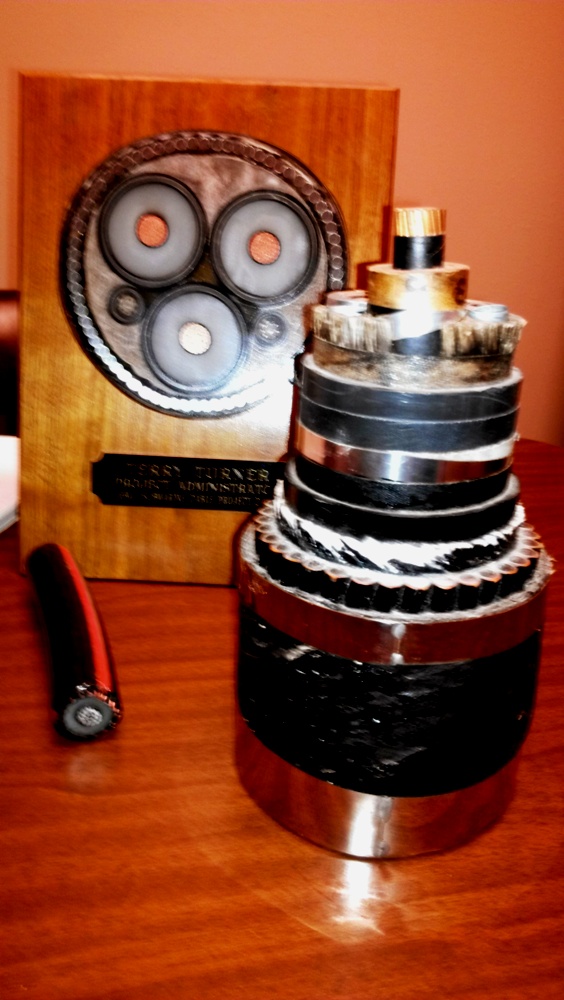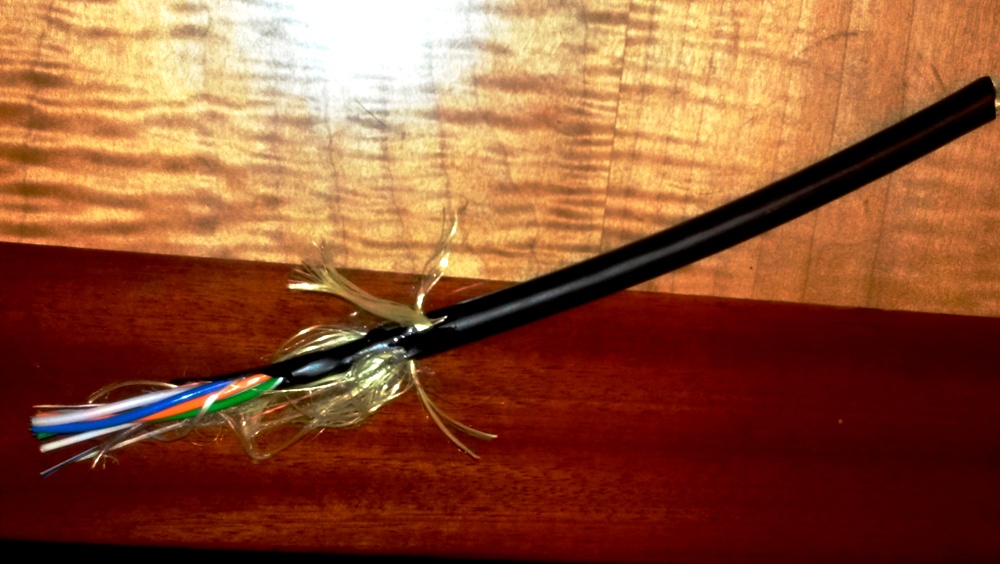Surveys show that 97 percent of those surveyed were not satisfied with their current internet service
By Margie Doyle
Updated Feb. 1 at 6:30 p.m.
Internet Broadband Service — it sounds big, broad and “out there,” and if OPALCO (Orcas Power and Light Cooperative) members decide by signing up in advance for improved, expanded wireless- fiber optic service, the county will enter a new era of telecommunication.

The old technology of electricity. From the left, electrical cable that’s been servicing OPALCO members for years; center, a modern submarine cable. Right, older submarine cable.
OPALCO’s Broadband initiative, if acted upon, would bring expansion to the electrical cooperative’s telecommunications infrastructure expansion, thereby providing:
- Access to telecommunication tools and improvements to improve energy efficiency and reliability
- Improvement of communications among local emergency systems and first responders
- Ability to access the internet at a minimum speed of 10 megabits per second (as compared to Orcas Island’s “standard” of 2+ mbps)
- Infrastructure improvements for cell phone companies to expand their services
In this article, the History, Current State, Cost and Next Steps of the Broadband Initiative will be covered. Documents addressing the Summary of 18-months study and Frequently Asked Questions (FAQ) can be found at the OPALCO website: www.opalco.com/programs/broadband-initiative/
History
OPALCO started out as an electrical coop 75 years ago. It was formed as a cooperative because the islands’ small population couldn’t attract the services that a profit-making company with a larger customer basis could provide.
Within the rural cooperative, revenues have always off-set the cost of OPALCO service to its members. Every dollar in revenue goes to pay for current, upgraded and planned services.
Voice and internet are delivered via copper cables, but copper has its limitations and the cabling system degrades over time. Today, when a number of people are using DSL or the internet in one area (including for the heavy-demand modern communications “devices,”) it’s like multiple demands on water lines. The pressure of the current constricts as more people make use of it, and so the capacity is lessened to individual connections.
Beginning in 2001, when OPALCO couldn’t meet its own communication needs with what Century Tel then offered with the then-traditional cables, it decided to invest in fiber optics for increased transmitted data and system reliability.
At the OPALCO plant on Mt. Baker Road in Eastsound, one can see the SCADA (Supervisory Control and Data Acquisition) board monitoring information about the power that comes to the county from Bonneville Power and then is distributed to members on Orcas, Lopez and San Juan Islands. (OPALCO offices on Lopez and San Juan Islands also have SCADA boards.)
OPALCO’s Communication and Outreach Manager Suzanne Olson says the “tremendous fiber optic network, through which all our substations are tied together, can identify faults and problems, monitor usage and solve outage issues without sending linemen out. OPALCO can anticipate problems before they become faults and identify the location of problems” through the information sent back to it through the fiber optics system.
Beyond monitoring and controlling power quality, the fiber optic system has the potential for “tremendous” capacity to serve islanders in the areas of telecommunications: internet data transmission; television streaming, cell phone usage. OPALCO has already made this additional capacity to public entities such as sheriff and fire stations, libraries and hospitals. Most of these entities were able to get grants to cover the costs of installation. Some individual coop members have also signed on, usually private businesses.
Because of the high cost of linking to the fiber optics network, it’s prohibitively expensive to the “regular” person, says Olson. To expand OPALCO’s fiber optic system to serve all its members county-wide involves costs in the construction to install the fiber optic cables, often through the islands rocky, forested terrain.
In 2009 the San Juan Island Community Foundation’s Critical Needs Task Force identified improved broadband access as one of the most important issues in the county. OPALCO joined with the San Juan Community Foundation and the County Economic Development Council to explore solutions. Surveys conducted at a later date indicated that 97 percent of those surveyed were not satisfied with their current internet service.
Now, after 18 months of investigation OPALCO has considered various technologies and decided upon a hybrid fiber optic-wireless system to address the demand for improved internet to provide for public safety; broaden and accelerate telecommunications; and continue to maintain and build out cooperative services as new technologies become available.
Currently
The hybrid system proposed by the OPALCO board would prove faster and more reliable broadband service, public safety communications and provide structure for improved cell phone usage.
In compliance with the county “wireless ordinance” passed in 2012, OPALCO would make available its infrastructure for joint use, so that, for example, a cell phone company can lease capability from OPALCO, and avoid the high costs of developing the next technologies itself.
A side note: OPALCO has responded to aesthetic concerns about towers and poles by limiting their heights.
Cost
With its investment in fiber optic cables over the last decade, OPALCO is well-positioned to build a county wide broadband network, Olson says. And while fiber optic cables are the foundation of OPALCO’s network, the cost of extending fiber-optic lines to each home is estimated to cost $79 million. That’s why the electrical cooperative board has recommended a hybrid system, combining the fiber optic cable network with wireless services — estimated to cost $34 million.
The plan is to build out as much fiber as is practical in population centers (roughly, Friday Harbor, Eastsound, and Lopez Village) and from those hubs, bring fiber out along distribution lines, until the point where it makes more sense to implement wireless service, where wireless signals can provide the connection.
With this “hybrid” system, OPALCO estimates it can cover 90 percent of the county.
A loan from the federal Department of Agriculture’s (USDA) Rural Utilities Services will fund the project, Subscribers to the broadband service will pay $75 month; every coop member will pay $15 infrastructure fee to support the expansion. A voluntary member donation program like Project PAL will support members who cannot pay the coop infrastructure fee.
OPALCO itself would not become a cell phone service provider but would provide the infrastructure to expand cell phone provider services within the county. The lease fees from cell phone providers would provide a third source of revenue for the broadband expansion project.
Olson says, “The board … recognizes that providing these services requires a major financial commitment.”
Financial models show that at least half the members (about 5,000 households) need to pre-subscribe to implement the project. If that number “buys in,” the OPALCO board will then make the recommendation to go ahead with construction of the enhanced broadband system. The first service could come as early as 2014, and a two-year project is anticipated.
Next Steps
Now OPALCO begins the effort to “measure community commitment” and to refine its assumptions about the plan.
It will inform members about all aspects of the initiative emphasizing face-to-face events as well as providing updated information on its website: opalco.com/programs/broadband-initiative/
Frequently Asked Questions(1/21/13)
Broadband Findings Document (1/21/13
“It’s not our job to sell anything to the members,” says Olson, but to let them know, “Here’s what we’ve learned. What would you like OPALCO do?”
Financials show that half the members (about 5,000 households) need to pre-subscribe to continue the project. If that happens, the OPALCO board will then make the recommendation to go ahead with construction of the enhanced broadband system.
If less than half the membership pre-subscribers, Olson says, “The board won’t be spending member capital. It’s up to the members.”
In an informal poll conducted by Orcas Issues from January 23 to 30, 2013, readers said:
- I’m a member of OPALCO and support expanding the broadband as they propose and will pre-subscribe (40%, 20 Votes)
- I’m a member of OPALCO and do not support expanding broadband as they propose (8%, 4 Votes)
- I’m a member of OPALCO and need to know more before making my decision (52%, 26 Votes)
**If you are reading theOrcasonian for free, thank your fellow islanders. If you would like to support theOrcasonian CLICK HERE to set your modestly-priced, voluntary subscription. Otherwise, no worries; we’re happy to share with you.**









How much does pre-subscribing cost? And where do we sign up??
Do I understand correctly that the proposed $75 subscription charge INCLUDES regular telephone service with unlimited long distance?
Go to “Frequently Asked Questions” in the article, and see that the $75./mo fee includes internet & local & long distance phone service. Check what you’re paying now for these services…could be that it’s more than the proposed $75.
It also explains the $15/mo fee to all OPLCO members.
Pete and Susan, thanks for contributing to what promises to be a complex and thorough discussion. Margot, thanks for pointing people in the right direction.
Please refer to the Frequently Asked Questions which you can find on the OPALCO website (Included in the article above at http://www.opalco.com/programs/broadband-initiative/) It answers questions about telephone service, which I understand will NOT be part of the broadband subscription charge.
IF half the OPALCO coop members pre-subscribe to the broadband service at $75, then ALL members will be charged an additional $15 on their monthly OPALCO bill, even those who don’t sign up for the enhanced broadband services.
OPALCO has done a terrific job of summarizing their research and answering the most frequently-asked questions at their website with the links provided in the article. It’s kind of like “reading the manual” but as someone who usually does that as a last resort, I urge people to read those documents. They answer a lot of questions.
Margie Doyle
Re phone services , here is what OPALCO FAQ’s say “Q Could I use this system to replace my telephone service as well as my DSL service?
A Yes. Included with your broadband, OPALCO will provide unlimited local and national phone services using your existing phone and phone number.” If this is accurate, sounds like price might be comparable or even better than what folks pay now.
Is there a way to determine whether the service will extend to our parcel? The maps show blank areas nearby.
On February 7th, a group of interested Islanders, including local ISPs joined a discussion group to examine the details of the OPALCO plan and process.
As of today, 560 interested Islanders have joined the group. We are discussing some of the details including detailed questions on the plan.
– 911 service
– cost of installation
– policies
– supporting local small business ISPs.
– similar community projects and their experiences.
Our aim is to have a balanced view of the risks and benefits of the OPALCO plan, and offer details and references to anyone who would like to join the group.
The group serves as a lobby for discussions that may head off to OPALCO meetings, and other online forums.
At present, it is the largest group of Islanders engaged in this discussion. All are welcome to join.
The URL is here:
https://www.facebook.com/groups/425195627559375/